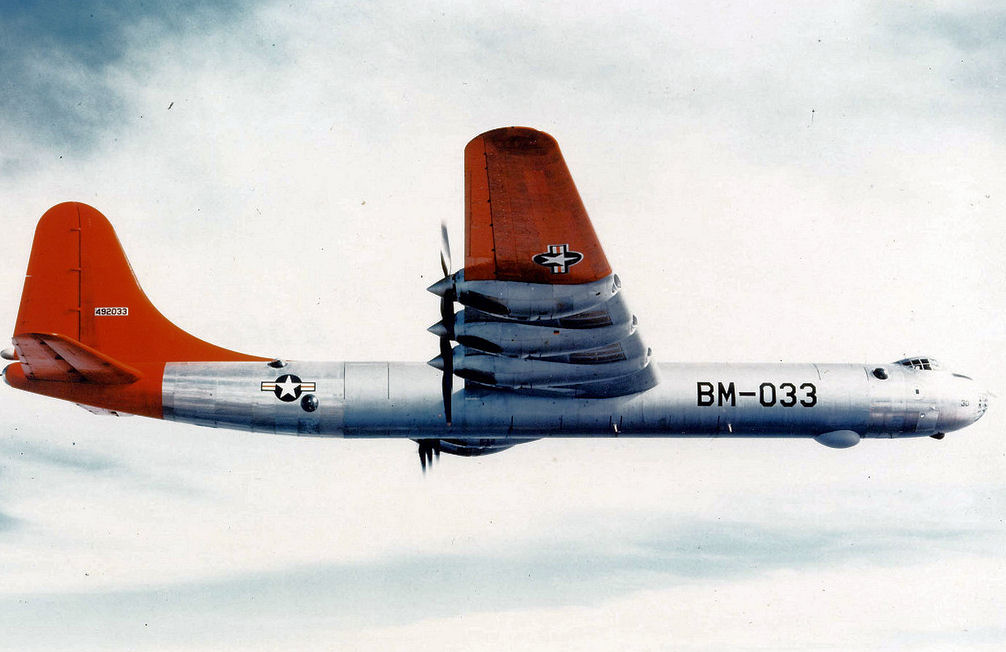
Blog
-
Geiger Readings for Nov 09, 2016
Ambient office = 66 nanosieverts per hourAmbient outside = 145 nanosieverts per hourSoil exposed to rain water = 141 nanosieverts per hourEndive from Central Market = 130 nanosieverts per hourTap water = 74 nanosieverts per hourFilter water = 59 nanosieverts per hour -
Nuclear Weapons 240 – Atomic Bomb Lost Of British Columbia In 1950 May Have Been Found
Late on February 13th, 1950, a U.S. Air Force Corvair B-36 intercontinental bomber was flying over the northwest coast of Canada on a simulated nuclear bombing mission over the U.S when three of its engines caught fire. The Corvair B-36 was carrying a Mark IV atomic bomb containing uranium and five thousand pounds of conventional explosives. There was no plutonium core in the bomb so it could not have been detonated. It was reported that the crew jump out of the plane which subsequently crashed in the Pacific Ocean.
Eventually, the U.S. government admitted that the plane carried an atomic bomb. It was reported that the crew jettisoned the bomb and detonated the conventional explosives over the Inside Passage off the coast of British Columbia. This incident was the first accident involving a U.S. nuclear weapon. This type of event is referred to as a “Broken Arrow” by the U.S. military.
The captain of the Corvair B-36 took the plane over Princess Royal Island so the crew could parachute onto dry land. He set the autopilot to fly the plane over open ocean before he bailed out. At the time of the crash, Canadian authorities were not told that the plane carried an atomic bomb.
Four years after the crash, planes searching for the wreckage of a private plane spotted the wreckage of the Corvair B-36 in a remote area of British Columbia’s coastal mountains. The location of the wreckage was three hours flying time in the opposite direction from where the Corvair B-36 was supposed to have crashed in the ocean. A search party on foot finally reached the site of the wreckage in August of 1954. That expedition removed certain important pieces of equipment and then blew up the remaining wreckage. In 1997, a Canadian and an American expedition reached the site and studied the what was left of the wreckage.
On a recent diving trip to Banks Island near the border between Alaska and Canada in the Inside Passage, Sean Smyrichinsky found something strange in the water. He said that it resembled a bagel cut in half with a ring of bold around the bagel. He told his crew that he might have found the wreckage of a UFO. Smyrichinsky mentioned his find to people in the area and someone told him about the Corvair B-36 bomber that crashed in the area in 1950. When he examined a picture of a Mark IV atomic bomb, he said that it looked like what he had found.
The Canadian Armed Forces confirmed that it appeared that Smyrichinsky had found the bomb from the Corvair B-36. He assures the public that the bomb is only a practice bomb and could not cause a nuclear explosion. The Canadian Royal Navy is dispatching ships to the area to examine the object found by Smyrichinsky. However, An aviation historian from British Columbia named Dirk Septer claims that his analysis of the Corvair B-36 incident indicates that whatever Smyrichinsky found, it could not be the lost atomic bomb from the Corvair B-36. The Royal Navy ships should arrive in the next few weeks and may definitively determine exactly what the object in the water is.
Corvair B-36 bomber:
-
Geiger Readings for Nov 08, 2016
Ambient office = 134 nanosieverts per hourAmbient outside = 81 nanosieverts per hourSoil exposed to rain water = 92 nanosieverts per hourCarrot from Central Market = 87 nanosieverts per hourTap water = 109 nanosieverts per hourFilter water = 100 nanosieverts per hour -
Radioactive Waste 198 – New Process Can Immobilize Iodine-129 in Glass Logs At Room Temperature
One of the biggest problems with nuclear power generation and nuclear weapons development is the radioactive waste that is created. Some of these waste materials can be dangerous for millions of years. There have been a variety of suggested approaches for locking such waste away. One system of waste disposal that the U.S. has been trying to develop is a deep geological repository so the waste can be buried underground. Even tucked away underground in a mine, there is a danger that ground water could penetrate the repository and leach out the radioactive materials if they are stored in barrels. It is even possible that leached materials could collect and start a nuclear chain reaction.
The process of vitrification was developed to help prevent this. In vitrification, radioactive waste is combined with a mixture of materials including sand. Then the mixture is heated until it melts and fuses into a glass log which is then stored in the repository. Making glass logs with the waste can immobilize it for tens of thousands of years at the least.
The scientists at the Hanford Nuclear Reservation have spent millions of dollars on a vitrification plant. Unfortunately, the waste they are trying to treat is highly varied with respect to chemical composition, granularity and viscosity. It turns out that the varied composition of the waste stream being fed into the vitrification plant was generating turbulence that could rupture piping, releasing explosive hydrogen gas. They had to stop work on the plant so they could modify the design. They are still working on completing the vitrification plant at Hanford.
Ashutosh Goel at Rutgers has been researching vitrification for decades. He is an Assistant Professor of Materials Science and Engineering. His latest project is the invention of a new method that can immobilized radioactive iodine in a ceramic material at room temperature. Radioactive Iodine-129 is very dangerous to human health. If it is released into the environment, it will disperse quickly in air and water and can stay around for millions of years. Iodine-129 accumulates in the human thyroid gland and increases the chances of developing cancer. Goel is also working on six other glass related project with funding totaling over six million dollars.
The U.S. Department of Energy provided much of Goel’s funding. They are charged with cleaning up the waste from decades of nuclear weapons research carried out at sixteen major facilities located in remote areas of Idaho, Nevada, South Carolina, Tennessee and Washington state. The Hanford Nuclear Reservation in Washington is one of DoE’s most difficult clean up jobs. Other institutions that Goel is working with include the National Science Foundation, Corning Inc., Washington State University, University of North Texas and the Pacific Northwest National Laboratory.
One of Goel’s major breakthroughs involves mass producing chemically stable apatite minerals also known as glasses, to immobilize iodine-129 without needing the high temperatures that other such processes require. He is also working with biosilicate glasses that don’t crystallize for the purpose of immobilizing sodium and alumina in high-level nuclear waste. Eventually, the work of Goel could possibly useful in the treatment and disposal of spent nuclear fuel which is piling up at cooling pools at reactors all over the U.S.
Ashutosh Goel:
-
Geiger Readings for Nov 07, 2016
Ambient office = 108 nanosieverts per hourAmbient outside = 63 nanosieverts per hourSoil exposed to rain water = 75 nanosieverts per hourJalapeno pepper from Central Market = 79 nanosieverts per hourTap water = 76 nanosieverts per hourFilter water = 68 nanosieverts per hour -
Geiger Readings for Nov 06, 2016
Ambient office = 119 nanosieverts per hourAmbient outside = 96 nanosieverts per hourSoil exposed to rain water = 113 nanosieverts per hourBrussel sprout from Central Market = 72 nanosieverts per hourTap water = 129 nanosieverts per hourFilter water = 122 nanosieverts per hour





